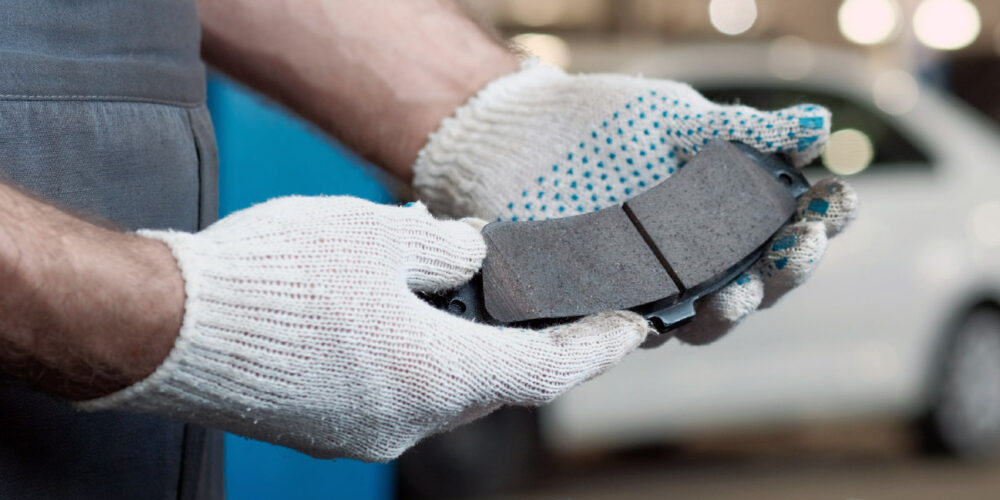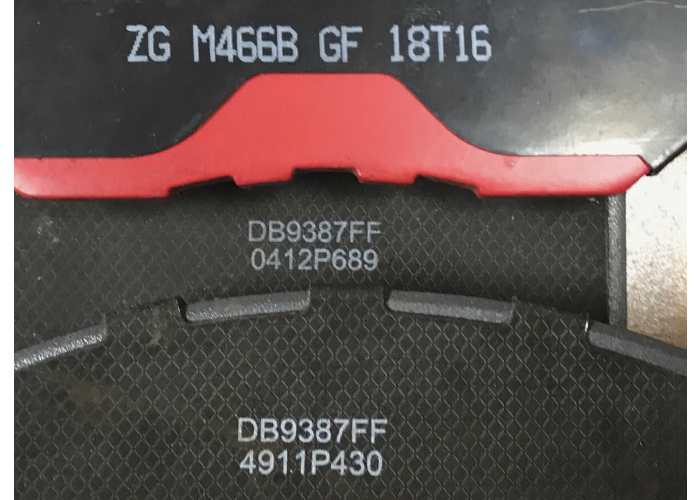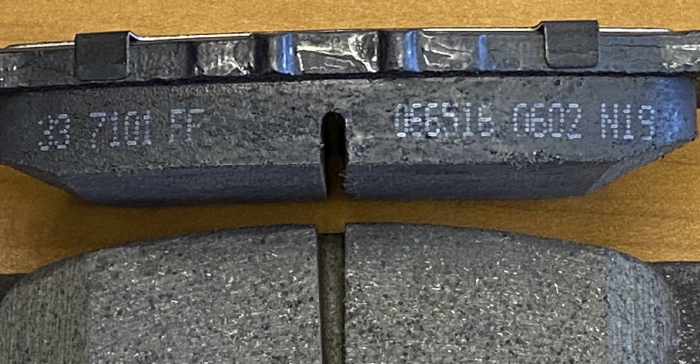When a brake pad is manufactured, one of the last steps involved is to print a series of letters and numbers on the edge of the friction material. This code has been on brake shoes and pads for more than 60 years, but what does it mean?
The “Edge Code” can tell you information about a brake pad’s friction material. These letters and numbers can help you to select the correct brake pads or shoes for a vehicle. But, the edge code can do only so much.
The edge code is a language written by engineers, federal entities and industry associations. Like any language, edge coding has its own “grammar” defined by standardized vehicle and laboratory tests. If you are to take one thing away from this article, it should be how to read the letters that correspond with the friction levels.
Most of the other information in the edge code is about creating accountability. The first two or three letters indicate the manufacturer of the brake pads. The following sequence of four to eight numbers or letters indicates the application that might mirror the catalog. The next sequence of letters and numbers can indicate the friction formulation used by the manufacturer. These letters and numbers can help investigators track the origins of a brake pad.
The subsequent two letters in an edge code indicate the friction material’s cold and hot friction levels. These letters will never tell you if a brake pad will make noise or last a long time. But, they can help you decide if friction material might match the original formulation. To understand how the letters indicate friction levels, you must know about the 60-year-old test.
In the 1960s, many domestic automakers were looking for a way to perform quality control on the friction materials being delivered to their factories. Since many of the OEMs used the same friction material suppliers, it only made sense to come up with a test method that compared apples to apples and was fast and cheap to perform.
When SAE published standards – The Society of Automotive Engineers (SAE) Practice J661 and SAE Practice J688 (truck standard) – they were reviewed and tweaked by all concerned parties, including OEMs, suppliers and governmental bodies. The purpose of J661 and J688 is to establish a uniform laboratory procedure for securing and reporting the friction and wear characteristics of brake linings.
How is a J661 or J688 performed? First, you need a special test machine called a Chase machine. This machine has an 11” drum attached to an electric motor. Mounted next to the drum is an arm or jig with a small friction material test sample with three temperature sensors. The arm will press the friction material into the drum.
The drum has a heater that can simulate a hot brake application. The rotation of the drum is measured as the friction material is applied under different heat conditions. The test results will determine the friction levels and assign a letter for hot and cold. The test also can measure the fade resistance of the friction material.
Letters are used to denote the coefficient of friction for both hot and cold. It does not determine the performance of the friction on a specific application. The letters can range from C to H. The letter C indicates the least aggressive, and H indicates the most aggressive. Some pads might have a ZZ in the code. This indicates that the friction material can’t be classified by the J661 test. ZZ codes are typically found on very aggressive performance friction materials.
Wear measurement results are not indicated in the edge coding. It does not mean that the car will stop in a safe distance or will not make noise. Edge codes should only be used to determine if the friction material will match what was installed on the vehicle for cold and hot friction.
The edge code is also evolving. In 2014, when the Better Brake Law was implemented for California and Washington State, two new pieces of information were added to the edge code. The first part was a letter indicating the level of copper and other materials in the friction material. The second was a two-digit number indicating the year of manufacture. These are in the last three places in the edge code. These two additions to the edge code allow regulators to determine if a brake pad meets the requirements for the 20-year phase-out of copper.
An edge code will not tell you if a customer’s vehicle will last 50,000 miles or if every stop will be whisper quiet. What an edge can do, however, is help you perform your quality control to make sure the friction level matches the original materials.
















